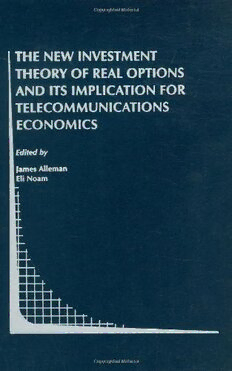
The New Investment Theory of Real Options and its Implication for Telecommunications Economics (Topics in Regulatory Economics and Policy) PDF
274 Pages·1999·9.205 MB·English
Most books are stored in the elastic cloud where traffic is expensive. For this reason, we have a limit on daily download.
Preview The New Investment Theory of Real Options and its Implication for Telecommunications Economics (Topics in Regulatory Economics and Policy)
Description:
The issue of costing and pricing in the telecommunications industry has been hotly debated for the last twenty years and we are still wrestling over the cost of the local exchange for access by interexchange and competitive local exchange carriers, as well as for universal service funding. With the advent of competition, the historical costing schemes had to change. Federal regulators wanted to ensure that monopoly rates did not subsidize competitive offerings. As a result, various costing methodologies were devised to allocate costs among the dominant carriers' services. The issue of costs can be summarized as two-fold: the quantitative determination of the level of costs and the proper attribution of those costs. Both are fraught with questions. The amount of costs, for instance, can vary from book costs to marginal costs. The attribution of costs can vary from those that are directly attributable to those that are joint and common. Hence, the need for costing theories and models. The industry is constantly in search of theories and models that more accurately reflect the underlying costs of service. It is in this light that the papers have been compiled for The New Investment Theory of Real Options in Telecommunications. Real options theory attempts to consider management's flexibility in valuation analysis and corrects the deficiencies of the traditional discounted present-value and decision tree analyses. This book sets forth an introduction and overview of the subject, and then provides the reader with a primer on real options. The volume highlights the controversies that surround the application of real options in the telecommunications industry; however, the editors have effectively separated the issues of application from those of interpretation.
See more
The list of books you might like
Most books are stored in the elastic cloud where traffic is expensive. For this reason, we have a limit on daily download.
